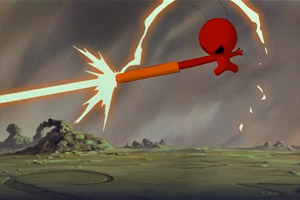 Prelude
to Eden was my great animation experiment. At the time
I started this project, I’d been working for Bluth for over
4 years. Although being there was a tremendous learning experience,
I wasn’t that thrilled with the kind of animation I was
doing. The Bluth style is fine, but what I really wanted to do
was the "Gagné" style, or at least find out what
the Gagné style was. Prelude to Eden was
the film that helped me find my own sense of storytelling,
timing,
motion and design. It was total artistic self-exploration.
Prelude
to Eden was my great animation experiment. At the time
I started this project, I’d been working for Bluth for over
4 years. Although being there was a tremendous learning experience,
I wasn’t that thrilled with the kind of animation I was
doing. The Bluth style is fine, but what I really wanted to do
was the "Gagné" style, or at least find out what
the Gagné style was. Prelude to Eden was
the film that helped me find my own sense of storytelling,
timing,
motion and design. It was total artistic self-exploration.
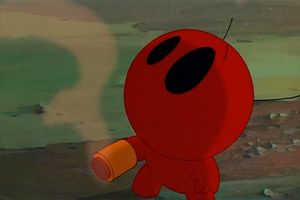 I
started the film in 1991 after coming back to America
from a 4-year
stint at the Bluth unit in Ireland. I’d just
transferred back to the LA branch and I was pretty
depressed. I was looking
for an outlet to give some kind of meaning to my life.
Some people join churches and organizations, me, I
just immersed myself into
this project.
I
started the film in 1991 after coming back to America
from a 4-year
stint at the Bluth unit in Ireland. I’d just
transferred back to the LA branch and I was pretty
depressed. I was looking
for an outlet to give some kind of meaning to my life.
Some people join churches and organizations, me, I
just immersed myself into
this project.
At
first, I wasn’t sure what story I was going
to tell. I just started. I'd always wanted to animate
an atom with electrons spinning
around over a black background. I don’t know
why. It’s
an image that's been stuck in my mind ever since I
saw "Our Friend the Atom" back in high school. So the
film starts with an energy blast from which a spinning
atom
is created.
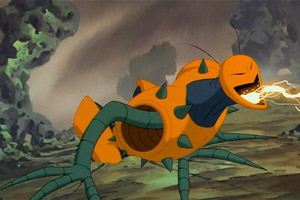 From
there, a
basic premise emerge: Before
there was life on Earth, or before there was even
an Earth in
the galaxy, or before there was even a galaxy in the universe,
or, indeed, before there was even a universe at all, there
was an epic battle between opposite forces. The outcome
of this epic
clash created the spark, which triggered the explosion known
as The Big Bang.
From
there, a
basic premise emerge: Before
there was life on Earth, or before there was even
an Earth in
the galaxy, or before there was even a galaxy in the universe,
or, indeed, before there was even a universe at all, there
was an epic battle between opposite forces. The outcome
of this epic
clash created the spark, which triggered the explosion known
as The Big Bang.
The
film took around 4 ½ years to complete from the moment of
conception to the delivery of the final 35mm print.
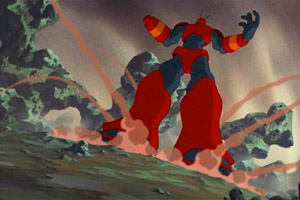 I
did most of the animation, although I can’t claim the full
credit. Back in 91 or 92, some of my animator friends saw the
pencil test of what I’d done, and they offered to contribute
some animation for it. Those guys volunteered their time and I’m
very grateful for it. I think their input has definitely
contributed to make the animation of Prelude to Eden more
powerful. I re-timed, cleaned up and reworked,
all the scenes
into my style to make everything fit into a cohesive
whole. The entire film was animated at 24 drawings
per second, so it took
a really long time to draw the whole thing.
I
did most of the animation, although I can’t claim the full
credit. Back in 91 or 92, some of my animator friends saw the
pencil test of what I’d done, and they offered to contribute
some animation for it. Those guys volunteered their time and I’m
very grateful for it. I think their input has definitely
contributed to make the animation of Prelude to Eden more
powerful. I re-timed, cleaned up and reworked,
all the scenes
into my style to make everything fit into a cohesive
whole. The entire film was animated at 24 drawings
per second, so it took
a really long time to draw the whole thing.
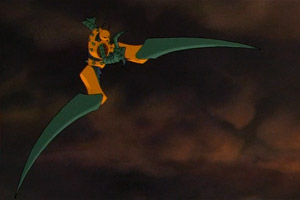 When
I made the decision to go color, I got great help from a talented
art director, named Barry Atkinson
whom I met at Don Bluth Studios. He did a wonderful job, orchestrating
the colors of the environments and creating truly memorable settings.
Other people that deserve mention are Shirley Walker (Batman:
The Animated Series), who created a powerful symphonic
piece to perfectly accompany the visuals. I was so impressed
with her composition that I ended up hiring a full orchestra
to record
the massive score. Another friend, Joe Campana, created the fantastic
multi-layered sound effects track.
When
I made the decision to go color, I got great help from a talented
art director, named Barry Atkinson
whom I met at Don Bluth Studios. He did a wonderful job, orchestrating
the colors of the environments and creating truly memorable settings.
Other people that deserve mention are Shirley Walker (Batman:
The Animated Series), who created a powerful symphonic
piece to perfectly accompany the visuals. I was so impressed
with her composition that I ended up hiring a full orchestra
to record
the massive score. Another friend, Joe Campana, created the fantastic
multi-layered sound effects track.
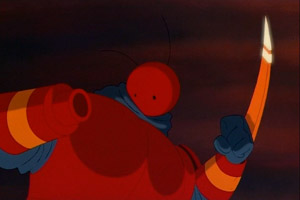 One
of the major challenges was trying to get the film done with
my small budget. In 1993-94, when I was ready to ink and paint
and composite the film, the technology was not nearly as advanced
as it is now. Traditional ink and paint on acetates were still
used by most studios. Disney had an ink & paint software
called CAPS, and there were a few studios offering color and
compositing services, but the price was exorbitant – especially
at film resolution. I knew I didn’t want to ink and paint
on acetate. I couldn’t. It would have taken me 10 years!
Besides, I had planned everything with digital technology in
mind.
One
of the major challenges was trying to get the film done with
my small budget. In 1993-94, when I was ready to ink and paint
and composite the film, the technology was not nearly as advanced
as it is now. Traditional ink and paint on acetates were still
used by most studios. Disney had an ink & paint software
called CAPS, and there were a few studios offering color and
compositing services, but the price was exorbitant – especially
at film resolution. I knew I didn’t want to ink and paint
on acetate. I couldn’t. It would have taken me 10 years!
Besides, I had planned everything with digital technology in
mind.
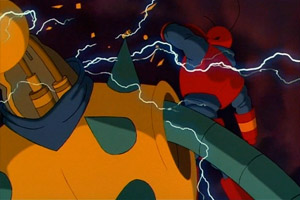 I
was at a standstill until my good friend Jon Hooper introduced
me to a couple of English gentlemen from Cambridge Animation
(UK) who were designing a new ink & paint software
called Animo. They needed a film to test and developed
their technology
and I needed software to finish my film. I signed a contract
with them stating that they could use the film to promote
their software, as long as they provided me with all the
necessary
equipment to finish it. It was a win-win situation. Jon
and I started painting and compositing in his bedroom on
his
NEXT computer,
sending feedback to Cambridge Animation every couple of
days. They basically designed the system to accommodate
us. Eventually,
Cambridge Animation got me an office in North Hollywood
and there, I spend about six months painting and compositing
the film. Jon
was my guiding light throughout the whole process, sharing
all his extensive computer knowledge with me.
I
was at a standstill until my good friend Jon Hooper introduced
me to a couple of English gentlemen from Cambridge Animation
(UK) who were designing a new ink & paint software
called Animo. They needed a film to test and developed
their technology
and I needed software to finish my film. I signed a contract
with them stating that they could use the film to promote
their software, as long as they provided me with all the
necessary
equipment to finish it. It was a win-win situation. Jon
and I started painting and compositing in his bedroom on
his
NEXT computer,
sending feedback to Cambridge Animation every couple of
days. They basically designed the system to accommodate
us. Eventually,
Cambridge Animation got me an office in North Hollywood
and there, I spend about six months painting and compositing
the film. Jon
was my guiding light throughout the whole process, sharing
all his extensive computer knowledge with me.
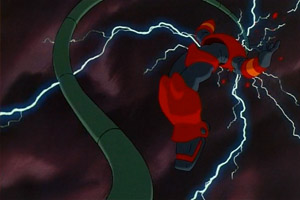 Prelude
to Eden was the first 35mm film resolution project
using Animo. Once the film was fully colored, I needed to output
all the
files on 35mm film. This was an extremely expensive process
- way above
what I could afford. At the time, Cinesite was eager
to break into the feature animation market. So once again,
I used my
win-win argument and gave Cinesite the right to use the
film to
promote their new technology in exchange of free services.
Prelude
to Eden was the first 35mm film resolution project
using Animo. Once the film was fully colored, I needed to output
all the
files on 35mm film. This was an extremely expensive process
- way above
what I could afford. At the time, Cinesite was eager
to break into the feature animation market. So once again,
I used my
win-win argument and gave Cinesite the right to use the
film to
promote their new technology in exchange of free services.
In
the end, I was able to complete the film with roughly $27 000,
which was my life saving at the time. Paying for the symphony orchestra
was my biggest expense.
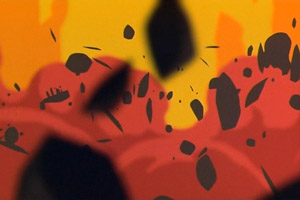 Prelude
to Eden
was shown at Siggraph and screened to various studio executives
around the world. Cambridge Animation started with software
that was unusable
for feature film purposes, and thanks to our feedback,
they were
able to get their program into shape and sell it to
major studios in Hollywood, including Warner Brothers
Animation,
Dreamworks
Animation, Rich Animation and many more. Cinesite also
used the film successfully to market their Cineon technology.
Everyone benefited from the collaboration.
Prelude
to Eden
was shown at Siggraph and screened to various studio executives
around the world. Cambridge Animation started with software
that was unusable
for feature film purposes, and thanks to our feedback,
they were
able to get their program into shape and sell it to
major studios in Hollywood, including Warner Brothers
Animation,
Dreamworks
Animation, Rich Animation and many more. Cinesite also
used the film successfully to market their Cineon technology.
Everyone benefited from the collaboration.
The
film received an Annie Award nomination (animation’s
industry equivalent of the Oscar) in 1996 for best
animated short.
Running
Time: 3 Minutes and 36 Seconds.

